The decision to transition to natural hair is a big one. Despite not being a living structure, our hair serves an important psychological function as it is closely related to our self-esteem. It impacts on our interpersonal relationships whether they are professional, social or just personal. So opting to go natural with a Big Chop is a Big Deal! That is why so many of us decide to go for a long-term transition letting our hair grow and gradually cutting it until we have no more relaxed hair.
This new journey might feel exciting and scary at the same time. You might have many questions and doubts and you may be going around in circles with all the information out there. Therefore, today I will give some direction on how to transition to natural hair. I will tell you some of the steps I incorporated in my hair routine and I hope this will be helpful to you too.
HERE ARE MY “12 COMMANDMENTS”
1| Stop Relaxing and Dyeing Your Hair – This might be quite obvious, but I had to say it. Relaxing and dyeing alter/damage your hair’ structure and over time it will lose its elasticity and strength, you will be left with hair that is dull and prone to breakage, unable to retain length. (Read Achieve Different Colours With Henna As A Natural Hair Die and Henna For Hair Care)
2| Stop Using Heat – Styling tools reach temperatures that will take all moisture from your hair, especially if you don’t know how to use them correctly. Again, your hair will feel dry, will have split ends and it will break. (Read 7 Flat Iron Mistakes To Avoid and Flat Iron’s ABC – Know The Lingo, Avoid The Woes!)
3| Pre-Poo Your Hair – This is something you do before you shampoo your hair. It typically consists of applying a vegetable oil (i.e. extra virgin olive oil or coconut oil) to the hair protecting and preventing it from the drying effects of shampooing. (Read Should You Pre-Poo Your Hair and 5 Tips to Make Your Oil Pre-Poo More Effective)
4| Avoid Shampoos With Sulphates – Sulphates are a common ingredient in shampoos that have a lathering effect. Its purpose is to clean your hair of any dirt, dust and product residue. However, it also takes away all sebum (hair’s natural oil) in your hair, leaving it dry and prone to breakage. (Read 6 Sulphate-Free Shampoos For Softer Curly Hair and 6 No-Poo Shampoo Alternatives)
5| Detangle Your Hair Very Well – Use plenty of conditioner to detangle your hair from ends to root. As your hair grows you will find that this task will become more difficult with the two textures. Getting rid of all the tangles in your hair, doing a protective style and restraining from over manipulating your hair will facilitate detangling on your next washing day. (Read 5 Tips For Detangling Transitioning Hair)
6| Deep Condition Regularly – This is very important to incorporate into your hair routine. African hair, because of its shape is predisposed to dryness, split ends, breakage and loss of elasticity. A deep conditioning treatment will basically work as “food” for your hair. It is applied to the hair and left to act for a minimum of 30 minutes. Best results are achieved when heat is applied. This way the cuticle layers of the hair open letting all the yumminess in to “assist” keratin in its job (give elasticity and strength). (Read Know Your Deep Conditioners and Jump-start Your Results and Know The Basisc to Make Your Natural Hair Homemade Deep Conditioner)
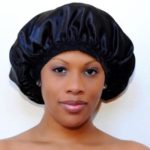 7| Use a Satin Pillowcase/Bonnet When Sleeping – Regular pillowcases and bonnets take the sebum off of your hair, leave it dry and pull it out. Satin pillowcases/bonnets won’t absorb the natural oils in your hair and or pull it out. (Read Essentials When Transitioning To Natural Hair)
7| Use a Satin Pillowcase/Bonnet When Sleeping – Regular pillowcases and bonnets take the sebum off of your hair, leave it dry and pull it out. Satin pillowcases/bonnets won’t absorb the natural oils in your hair and or pull it out. (Read Essentials When Transitioning To Natural Hair)
8| Do Protective Hairstyles – When doing a protective hairstyle you are protecting the ends of your hair, which are the oldest and most fragile part in your hair. Avoid applying too much tension to your hair, especially on the edges, as they will get thinner and more fragile. (Read Protective Hairstyles For Transitioning Hair, 7 Causes Of Thinning Hair Edges)
9| Moisture, Moisture, Moisture – This is key to healthy hair! Make sure your hair is well moisturised. If it feels and looks dry spritz your hair with water or apply a moisturizing cream. Just be sure that the first ingredient in the product is H2O (water). (Read 3 Moisturisers For Transitioning Hair)
10| Trim Regularly – A hair with thinning and split ends is a hair that has lost its protecting layer and has difficulties growing. Trimming your hair as it grows will get rid of relaxed ends and promote a healthy growing hair. You can trim your hair every 6 weeks or 3 months, you decide when. (Read When To Trim Transitioning Hair)
11| Stop Using a Cotton Towel – Using a microfiber towel will absorb water quicker, reduce frizz and friction since you won’t need to rub and squeeze your hair to remove excess water. (Read Essentials When Transitioning To Natural Hair)
12| Section Your Hair When Washing – Sectioning your hair reduces the time it takes to detangle it and avoids tangles and knots, which will reduce your stress level. (Read Reduce Hair Breakage When Washing Transitioning Hair)
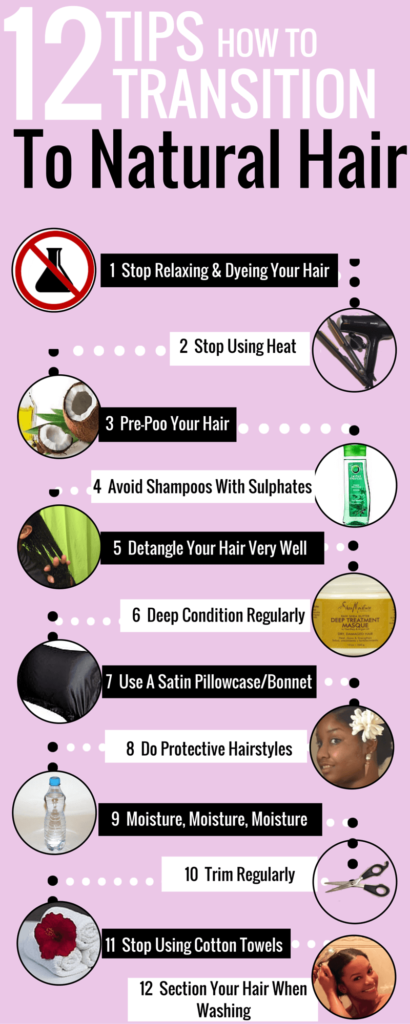
MORE IMPORTANTLY!
In this journey, you will find yourself exasperated, hopeless and at your wits end with your hair. There may even be a time when you’ll want to reach for that old friend – the relaxer. However, give yourself some time to see your hair grow, it will get easier as you get more attuned with your hair. I know this because it happened to me, but as I started to see my natural hair grow I fell in love with it and you will too.
So be patient, have fun trying new products and hairstyles and be gentle with your hair. You don’t want to rush or be rough with your hair, it will certainly damage it.
Finally, find support! It may be a family member or a friend, someone who will support your decision in your journey even if they don’t agree with you. Let me know if you’re already doing some of these “commandments” and which ones were easier/harder to implement.

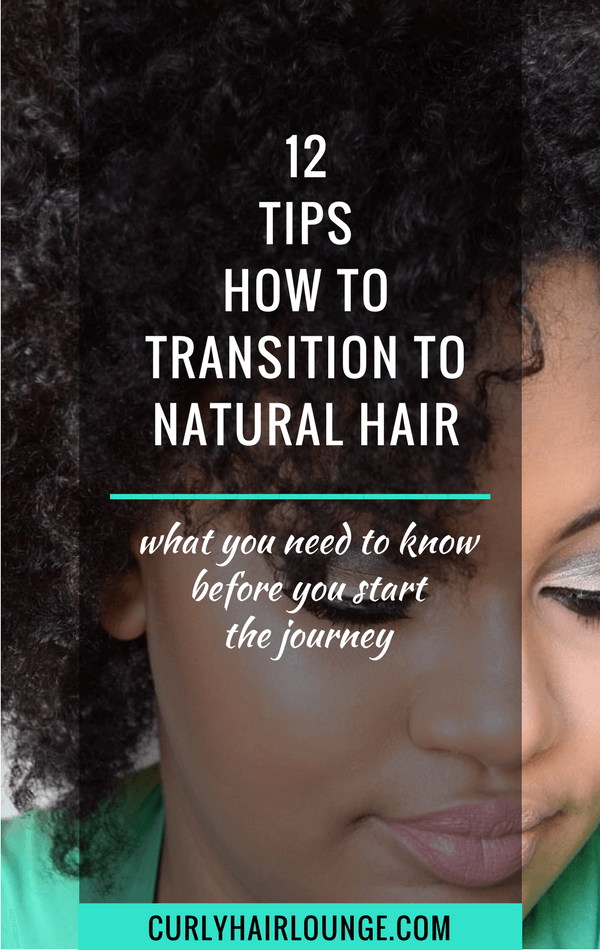
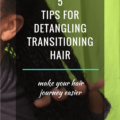

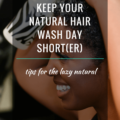
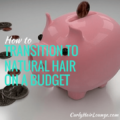

14 thoughts on “12 Tips On How To Transition To Natural Hair”
Great article! I had no idea about cotton towels, satin pillow cases and pre-poo hair! Amazing tips. Thank you!
Hello Kristina! Thank your you’re welcome.
Hi Monica,
Beautiful site with some very good information and natural tips.
I am a man who takes care of my curly-hair, so I shall be following your site from now on.
I like the way you introduce your visitors to Wealthy Affiliate, as I am sure you will inspire in many ways.
Best wishes,
Melvin.
Hi Melvin, It’s nice to see a man who takes care of his hair. Keep caring for those curls!
Hi I loved this article very informative and easy to read..will share this with a few friends.
Hi Theresa, I’m glad you liked it. Please do share with your friends and keep coming back I’ll love to see you here in the comments section!
I wish I would have known this when I had my long hair. This explains a lot of the trouble I had with it. Lots of good information here.
Hi Zavier, thanks for your kind comment.
I absolutely love your articles. I’m 5 months transitioning now and learning a lot. Thanks for sharing such good info. Quick question is putting a rinse to cover the gray considered dyeing? I’m not ready to be gray. I use Clairol Beautiful Collection Advanced Gray.
Thank you, Sharon! I’m glad you like our little space here. 🙂 I checked you colour hair rinse and it’s a semi-permanent dye. Temporary dyes are the least harmful to the hair and they only last a few washes. Semi-permanent, like yours, is a good compromise if you want your treatment to last more than 3 or 4 washes and it’s less harming than a regular hair colour treatment. Just make sure you give your hair some extra ‘moisture love’.
Alternatively, if you like DIY’ing you can do henna. I love it! I even have a recipe on the blog, you can also achieve different colours with it.
Take care.
Hi Monica, am a newbie about 5 months in with about 2 inches of new growth. Thanks for all the tips, they are very handy and easy to follow.
Am curious, whats your take on texlaxing? Is it an acceptable way to loosen the curl pattern a bit for manageability? Type 4 hair can be a piece of work with the curl pattern and shrinkage.
Hi Doreen
I can understand that as a newbie learning to deal with your new hair texture can be a challenge and texlaxing may seem like a good option. However, it can still damage your hair, your scalp and have adverse effects on your health. Managing your hair is no doubt a learning curve but it’s totally possible. Look out for people who have the same hair texture and see how they manage their hair, it can give priceless tips. Be patience, with time things will get easier. 🙂
Thank you for sharing beautiful. I’ve fallen back in love with my hair. It’s so thick, however; at the site of water, it shrivels up to the knottiest Sheep hair, I’ve ever seen. It breaks off often at the site of a comb. I’ve worn a wig for a year and keep my hair in a boxed Ceily style for the entire time. I would wash and condition it, every 3-4 weeks. This how it grew. I also started eating better. I truly thank you for these tips, and I am going to attempt them, however; it hurts to comb. Can you recommend a shampoo, without sulfate?
Hi Gloria! In order to properly clean the hair – which is the base of well moisturised hair – you need a sulphate shampoo. However, sulphates exist in a spectrum from strongest to mild. There are ‘sulphate free’ shampoos you can use to clean your hair that are able to remove product buildup, oils and butters but your hair regimen will need more. Please read this post to get a better understanding of sulphates why you need more than just mild sulphates. Here’s a list of sulphate free shampoos to use. Hope this helps. 🙂